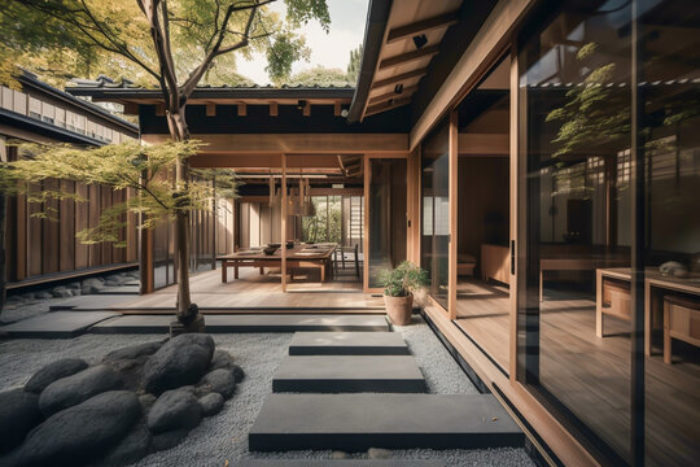Blending traditional Japanese roof house interior design with modern comfort creates a harmonious and inviting living space that pays homage to heritage while meeting the needs of contemporary lifestyles. Here’s how to achieve this balance:

- Minimalist Aesthetic: Embrace the minimalist aesthetic of traditional Japanese design, characterized by clean lines, open spaces, and uncluttered interiors. Keep the layout simple and functional, with an emphasis on creating a sense of calm and tranquility.
- Natural Materials: Incorporate natural materials such as wood, bamboo, and rice paper to evoke the warmth and authenticity of traditional Japanese architecture. Use these materials for flooring, wall paneling, and furniture to add texture and visual interest to the space.
- Shoji Screens and Fusuma Doors: Integrate shoji screens and fusuma doors into the interior design to create flexible living spaces that can be opened up or closed off as needed. These traditional Japanese elements provide privacy while allowing natural light to filter through, enhancing the sense of openness and connection to nature.
- Tatami Flooring: Consider using tatami flooring in designated areas such as the living room or bedroom to add a touch of traditional Japanese elegance. Tatami mats are made from natural rush grass and provide a comfortable and eco-friendly flooring option that complements the minimalist aesthetic.
- Furniture with Clean Lines: Choose furniture with clean lines and simple designs that complement the minimalist aesthetic of traditional Japanese interiors. Opt for low-profile seating such as tatami sofas or floor cushions, along with sleek and modern pieces that blend seamlessly with the overall design.
- Futon Beds: Incorporate futon beds into the bedroom design to enhance the traditional Japanese aesthetic while providing modern comfort. Futons are versatile and space-saving, allowing the bedroom to double as a living area during the day and a cozy sleeping space at night.
- Engawa or Genkan Spaces: Create engawa or genkan spaces at the entrance of the home to serve as transitional areas between the interior and exterior. These traditional Japanese features provide a place to remove shoes, store outdoor gear, and transition from the hustle and bustle of the outside world to the tranquility of the home.
- Natural Light and Views: Maximize natural light and views of the surrounding landscape to bring the outdoors in and create a sense of connection to nature. Use large windows, sliding glass doors, and skylights to flood the interior with sunlight while framing views of the garden or courtyard.
- Zen-Inspired Elements: Incorporate Zen-inspired elements such as indoor gardens, rock gardens, and water features to promote relaxation and mindfulness. These elements add a sense of serenity and balance to the interior design, enhancing the overall sense of well-being.
- Customized Lighting: Use customized lighting solutions to create ambiance and highlight architectural features. Incorporate soft, diffused lighting to mimic the warm glow of traditional Japanese lanterns, while also integrating adjustable task lighting for practicality and convenience.
By blending traditional Japanese roof house interior design with modern comfort, you can create a serene and welcoming living space that embraces heritage while catering to the needs and preferences of contemporary living. Striking this balance ensures a harmonious and timeless home that resonates with both tradition and modernity.



